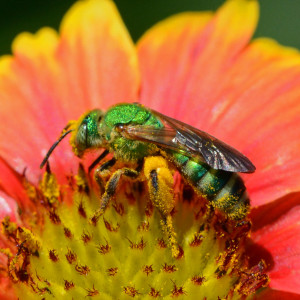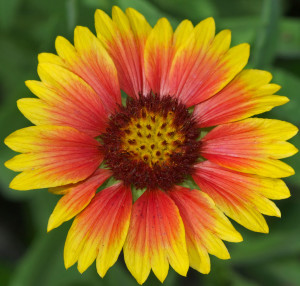…and the bees are buzzing with excitement. I was out in the yard at lunchtime, as usual, and I noticed more than the usual activity around the flowerbeds in front. There were these little yellow blurs zipping from flower to flower in the Gaillardia1. These are among the prettiest flowers in south Florida, although I must be honest, beauty is in the eye of the beholder. When I brought my native plant book to my son’s preschool to show to the director, one of the native Floridians who had been there for decades burst out “that’s a weed!” To which my response was “what better type of flower to plant in an area with lots of preschoolers than a weedy, hardy, one?” It didn’t carry the day, though, and there are no beautiful Indian Blanketflower plantings at the preschool. Oh, well. Sure is ugly, right?
Where was I? Oh, right. Out in the front yard, trying to figure out what these little yellow blips were. There were at least two, but I was never able to focus on them long enough for a picture. They would zip crazily along their patrol beat, skipping from flower to flower, alighting ever so briefly to find it empty and move on before I could so much as twitch my shutter finger. I wound up turning in circles trying to draw a bead on one of them but had to give it up after a few futile attempts.
Soon, though, I noticed a much calmer, green-colored blip that resolved into a bee digging for pollen all across these little plants. You can see how successful she’s been by how puffy and yellow her legs are:

She was working hard, keeping her head down and doing her best to ignore that little yellow blip buzzing around, but after a while it became impossible: as soon as one of the blips noticed her, it plunged down at her and appeared to be trying to carry her off! Earlier I had been trying to figure out whether these yellow guys were some sort of robber fly or hunting wasp, but this interaction narrowed down the possibilities enormously: it must have been either territorial aggression or an attempt to get down to business.
A minute or two later when one of the yellow blips finally settled on one of the flowers, perhaps to rest and reconnoiter a little bit, I was able to suss it out to my satisfaction. I zoomed in with my lens (not literally, of course, since it’s a fixed focal length macro, but…) to reveal this:

The attacker was none other than a male A. splendens looking to, ahem, get busy. I wasn’t able to get pictures of any of the attacks, but this node over at bugguide.net should give you an idea of the general nature of the proceedings, should you care to follow the link. Kudos to photographer Tim Lethbridge for that work!
I’m surprised, in retrospect, by how yellow the blips of the male bees on their patrol flights appeared; their thorax looks green in the pictures. I think, though, that it must give off a bit of a gold highlight which, combined with the yellow and black stripes on the abdomen as opposed to the green and black of the female, is probably responsible for the great difference in GISS.
According to Eric Grissell (2010: 220), sweat bees are “the most behaviorally complex of all the so-called solitary bees, ranging from solitary to communal, semisocial, and primitively eusocial.” Grissell provides some good information for the amateur taxonomist as well: the term “sweat bee” is a bit of a simplification, since this family includes entire groups of bees that aren’t all that interested in alighting on our arms and trying to drink up our sweat. (Although to be fair, many bees in the genus Lasioglossum reportedly do exhibit this behavior, although I’ve not witnessed it personally.) He calls the bees in the genera Augochlorella, Augochlora, and Agapostemon ” ‘little green bees’ because they have no common name and they are little and green.”
I also have to give props to the Xerces Society for the accuracy of their description of the genus: “a fast-moving metallic green blur over summer flowers is probably an Agapostemon.”
These bees are generally solitary nesters in bare soil, so it’s important to remember to leave some bare patches here and there if you want to encourage them.
References
Grissell, E. (2010). Bees, Wasps, and Ants: The Indispensable Role of Hymenoptera in the Garden. Portland: Timber Press.
Mader, E., Shephard, M., Vaughan, M., Black, S., and LeBuhn, G. (2011). The Xerces Society Guide to Attracting Native Pollinators: Protecting North America’s Bees and Butterflies. North Adams, MA: Storey.

